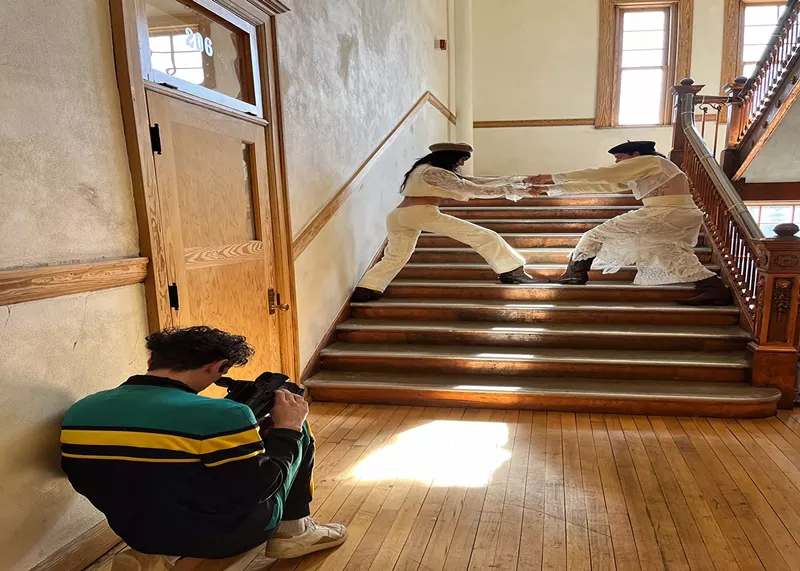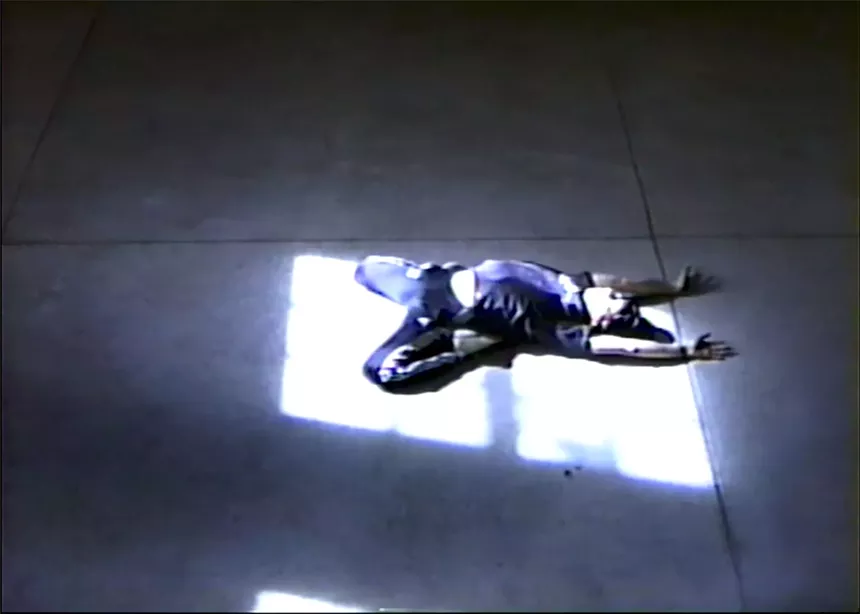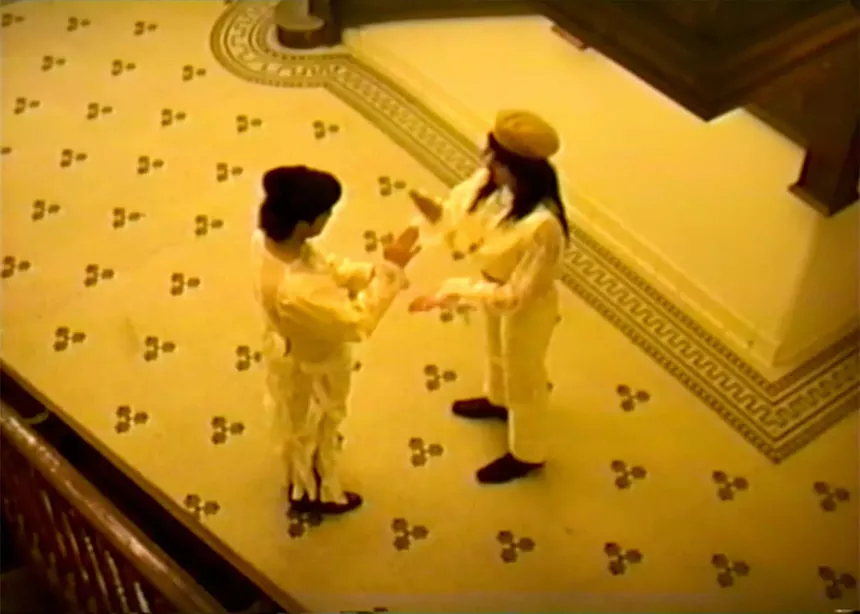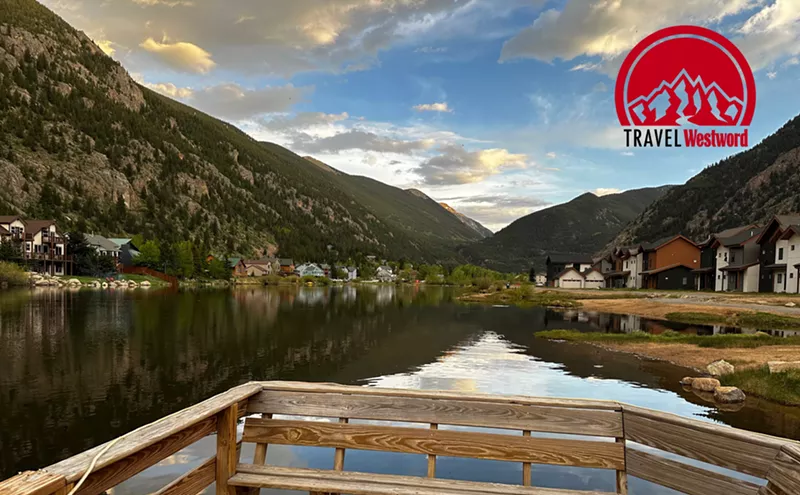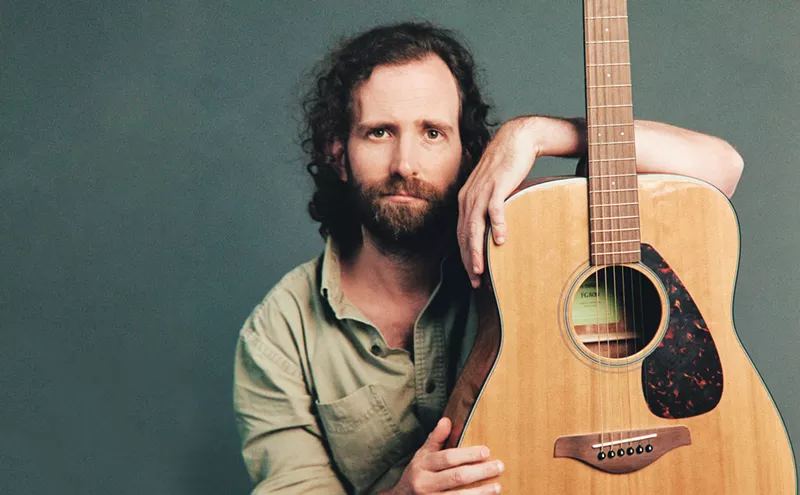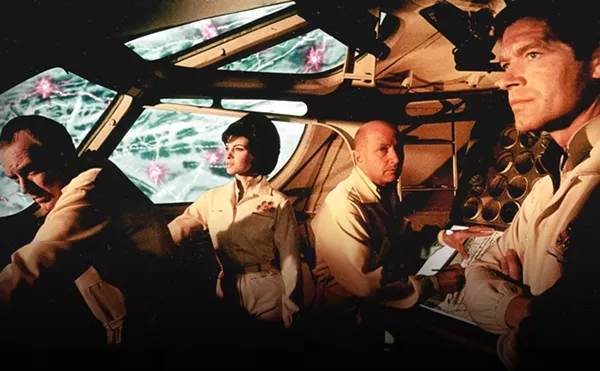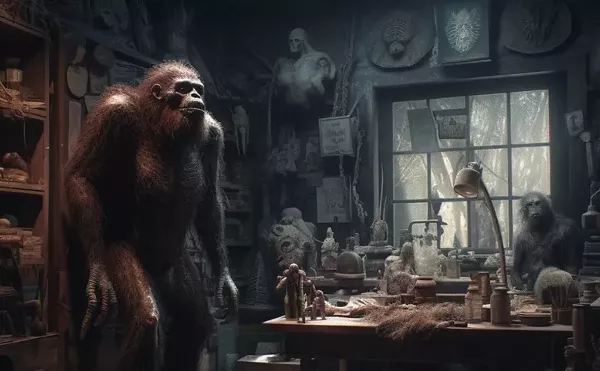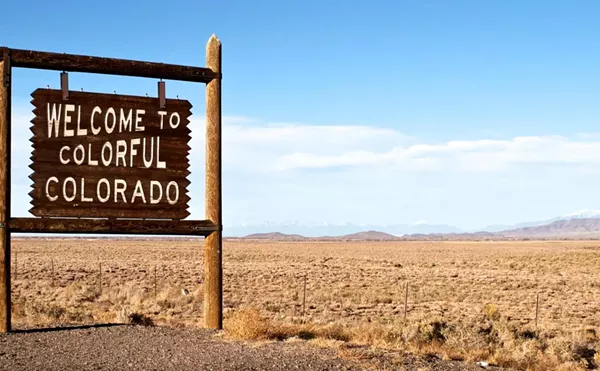The relationship between human identity and clothing has been explored for centuries, but no one has commented on the intersection of fashion and gender as keenly as Virginia Woolf in her gender-bending 1928 novel, Orlando: A Biography. "Different though the sexes are, they intermix," she wrote. "In every human being a vacillation from one sex to the other takes place, and often it is only the clothes that keep the male and female likeness, while underneath the sex is the very opposite of what it is above."
Nearly a century after that influential book was published, the concept of how clothing can affirm identity is just one of the topics that will be illustrated in the upcoming fashion show being produced by Below the Concrete artists Kit Bollag-Miller (they/she), María Morera-Nuñez (they/them) and Danny Vaughan (they/them). Fever: Performing a Fashion Manifesto will take place at an undisclosed location on Saturday, March 25, and will subvert typical ideas of fashion shows while entwining queer experiences into symbolic movements that encapsulate a chaotic, intoxicating dreamscape.
"The name Fever was extracted from the concept of a fever dream. I think for us it captures a bit of the discomfort, heat and suddenness of the performance," Bollag-Miller explains. "Given how different everyone participating in the show [is], we developed the concept because it seems to feed the goal of featuring lots of substories and plots while tying back to the (hopefully) radical ways we believe people can use fashion to self-curate as a manifesto. In a sense, it is a demand to explode who mainstream fashion has centralized, and an insistence on seeing models as humans instead of just bodies that are treated as disposable. We see discomfort as a necessary means for growth and change, which is what appealed to us about the concept of a fever dream."
A DIY collective, Below the Concrete formed last year to offer a community for trans and queer artists, and to showcase their thought-provoking work at house shows, with the location only provided to those who ask with good intentions. Given the collective's impressive growth spurt, however, the upcoming fashion show won't be explicitly a Below the Concrete event.
"The collective has grown to the size where we're sort of going to be doing satellite shows, breaking into smaller groups based on the space that we're able to get," Bollag-Miller explains. "So we came together through Below the Concrete, and it's featuring most people who are in Below the Concrete, who are going to be modeling. People will be able to learn about the show through the Below the Concrete Instagram; we'll be advertising it through there and taking direct messages and questions through that."
Bollag-Miller is constructing twenty designs for twenty artists who will perform choreography by Morera-Nuñez, and the whole process leading up to and during the show is being filmed by Vaughan, who will render the footage into a documentary that they hope to enter in film festivals. Bollag-Miller and Morera-Nuñez had been discussing the project since last year.
"The idea came up because we really wanted to highlight Kit's talents designing clothes. And based on what we've seen in Denver's fashion industry, we wanted to break that concept and create a new one for what a fashion show would be, making it into a performance, not only a fashion show," Morera-Nuñez explains. "We really wanted to make a show that is based on the queer community, and we've seen that the queer community's not highlighted in general in Denver fashion. We really wanted to highlight queer and trans people and their talents — not only as models, but as artists. For example, we have someone who is going to walk as well as sing, we have performers who are going to do movement, [and] we have musicians as well, who are going to play instruments during the show."
While models at typical fashion shows are used as walking mannequins, Fever will present them as muses and storytellers. To design the clothing and incorporate choreography, Vaughan, Bollag-Miller and Morera-Nuñez interviewed each of the artists who would model. "How the design is working, especially in the lens of queerness and queerness in fashion, is to affirm identity," Bollag-Miller says. "We're talking with everyone individually, which Danny's recording, about their affirmation in fashion, so each outfit designed is sort of a collaboration between me and them, to put together a concept that is affirming. The clothes are really designed for the person; it's not like I'm making the clothes for myself and then putting the people in them. To even further that concept, María as the choreographer is working with everyone on their individual interests and talents. And that's where the performance aspect comes into it."
The experience of filming the process hasn't just been enlightening, it's also provided them with deep connections and friendships, Vaughan says: "I really liked the idea of starting from this small idea and kind of observing the whole process and what will come of it. It's definitely a documentary that I don't quite know how it will end, which is the most intriguing thing for me, as well as getting involved in the community and getting to know people better who I've only known for a year. I kind of like getting to know everyone a little bit more."
The show will last around 45 minutes, with performance pieces of up to two minutes each along with live music and DJ sets. To immerse the audience in this fever dream, the content will flick rigorously from one subject to the next, with conceptual movements depicting everything from time travel to a dream of dog training, as well as a human behaving like a dog, a fairy scene and more. "We have the concept of a nightmare, too. So Kit shows clothes that resemble for them what a nightmare would look like, and they had conversations with the two artists that are going to prepare for that piece in the show about what feels affirming for them in clothes," Morera-Nuñez adds. "And then I met with them and we had a conversation about movement: What does a nightmare look like for them? We built a two-minute performance piece about what they would have as a nightmare, with clothes added in, and movement, as well."
It's all meant to be disruptive and fragmented, like a fever dream itself. Acknowledging such discomfort, Bollag-Miller notes, is part of the queer experience, while fashion is a deep aspect of embracing identity.
"For me, fashion allows me to embody my queerness and the fluidity of the way that I see my gender in a sense that's so dynamic. It can really change how I look from day to day — there's nothing concrete about clothes," Bollag-Miller reflects, adding that they've been mulling over a quote from nonbinary activist Alok Vaid-Menon about how fashion can be healing.
"In order to present in a way where your authenticity is against the mainstream, you need to heal yourself," Bollag-Miller continues. "I've been thinking a lot about how that's something that I strive for. And in order to feel comfortable wearing things that make people really uncomfortable around me, that's the process of healing yourself first. You need to heal yourself in that way to love that side of yourself and appreciate authenticity more than societal affirmation."
Creating such a monumental collaborative show has led Bollag-Miller, Morera-Nuñez and Vaughan to discover more about themselves in the process, too.
"Seeing Danny interviewing someone about how they feel about their identity and their relationship to clothes has been very eye-opening, and sort of a process of learning for me about our community and how people feel every day in their connection to clothes," says Morera-Nuñez. "And it's been a process of learning about our own community in a deeper way that I didn't expect."
"Just having more explicit and formal conversations, where you're asked to stop and think, 'What do you really want to embody?,' made me remember how valuable those conversations are," adds Bollag-Miller, "and how important it is to pause from your routines, to step outside of them and really push yourself and maybe think about directions that you want to grow in or things that you might want to experiment with and play with."
Steeped in so much self-reflection from the creatives, the show is sure to inspire viewers to examine themselves, as well. Making dreams a reality through fashion is just the beginning of an introspective journey, but Fever: Performing a Fashion Manifesto shows that it is also a vital act. As Woolf wrote in Orlando: "He who robs us of our dreams robs us of our life."
To learn more about Fever: Performing a Fashion Manifesto, message @belowtheconcrete on Instagram. A $10 donation is encouraged.

Audio By Carbonatix
[
{
"name": "GPT - Billboard - Slot Inline - Content - Labeled - No Desktop",
"component": "23668565",
"insertPoint": "2",
"requiredCountToDisplay": "2"
},{
"name": "STN Player - Float - Mobile Only ",
"component": "23853568",
"insertPoint": "2",
"requiredCountToDisplay": "2"
},{
"name": "Editor Picks",
"component": "17242653",
"insertPoint": "4",
"requiredCountToDisplay": "1"
},{
"name": "Inline Links",
"component": "18838239",
"insertPoint": "8th",
"startingPoint": 8,
"requiredCountToDisplay": "7",
"maxInsertions": 25
},{
"name": "GPT - 2x Rectangles Desktop, Tower on Mobile - Labeled",
"component": "24956856",
"insertPoint": "8th",
"startingPoint": 8,
"requiredCountToDisplay": "7",
"maxInsertions": 25
},{
"name": "Inline Links",
"component": "18838239",
"insertPoint": "8th",
"startingPoint": 12,
"requiredCountToDisplay": "11",
"maxInsertions": 25
},{
"name": "GPT - Leaderboard to Tower - Slot Auto-select - Labeled",
"component": "17676724",
"insertPoint": "8th",
"startingPoint": 12,
"requiredCountToDisplay": "11",
"maxInsertions": 25
}
]

